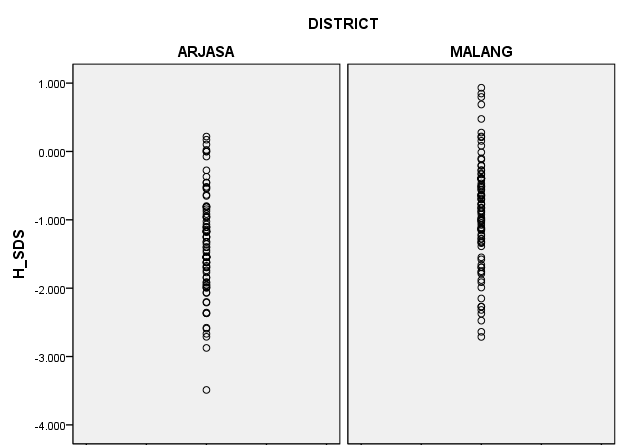
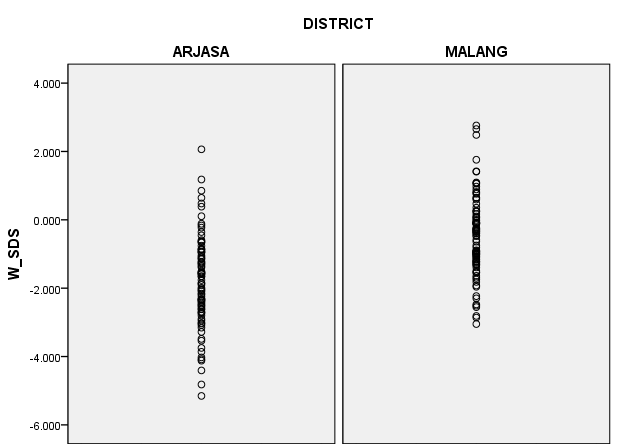

Figure 1 Comparison of height, weight, and Body Mass Index (BMI) for girls aged 15–17 years old on Kangean and in Malang, based on the WHO Growth Charts (WHO 2007)
Height of children and adolescents on the Kangean Island, Madura, Indonesia
Department of Child Health, Faculty of Medicine, Universitas Airlangga, Surabaya
Department of Child Health, Dr. Soetomo General Academic Hospital, Surabaya
Faculty of Medicine, Universitas Airlangga, Surabaya
Department of Child Health, Dr. Soetomo General Academic Hospital, Surabaya
Department of Child Health, Faculty of Medicine, Universitas Airlangga, Surabaya
DOI: https://doi.org/10.52905/hbph2025.1.89
BackgroundHistorical evidence highlights links between height and environmental factors, with geographic isolation playing a crucial role. The Kangean Island, one of Indonesia’s small, isolated islands, offers a unique context for research on growth.
ObjectivesThe study aims to compare the height of 15-17-year-old girls in Malang, Java, with those of the same age on Kangean. It also compares the height of boys and girls aged 1 month–12 years old from Arjasa and Kangayan locations over two hours away from the port on the Kangean Island.
Sample and MethodsWe studied 2 groups with a total of 393 participants: girls aged 15–17 years from Malang (n=91); and Kangean (n=94), children aged 1 month–12 years from the Kangean Island (n=208); we measured the participants’ height, weight, and BMI, converted them based on the WHO-reference SDS values from 2007, and then analyzed the data using SPSS.
ResultsCompared with Malang, female adolescents on Kangean were shorter (-1.42±0.79 vs. -0.88±0.79, p<0.001), had lower weight (-1.84±1.40 vs. -0.50±1.18, p=0.00), and lower BMI (-0.84±1.29 vs. 0.069±1.02, p<0.001). Kangayan boys were shorter than those in Arjasa (-1.67±1.00 vs. -0.83±1.36; p<0.001), while Kangayan girls were similar to their counterparts in Arjasa. There were no significant differences in weight between all the Kangan and Arjasa groups, but Kangayan’s children had a higher mean BMI-SDS than Arjasa’s (boys: -0.55±1.45 vs. -1.32±1.52; p=0.009; girls: -0.54±0.94 vs. -1.12 ± 1.04; p=0.01).
ConclusionLiving on a small island and the distance from its port differently affect the growth of children and adolescents.
Keywords: Height, Island, Isolated, Geographical, Growth
Conflict of interest statement: There are no conflicts of interest.
Citation: Hisbiyah, Y. et al. (2025). The role of geographical isolation in children’s growth. Human Biology and Public Health 1. https://doi.org/10.52905/hbph2025.1.89.
Copyright: Unless otherwise indicated, this work is licensed under a Creative Commons License Attribution 4.0 International. This does not apply to quoted content and works based on other permissions.
Received: 2024-09-29 | Accepted: 2025-01-16 | Published: 2025-07-11
AOR : Adjusted Odd Ratio
BMI : Body Mass Index
Kg : Kilogrammes
IFLS : Infant Feeding Leads
LMIC : Low-and Middle-Income Countries
SDS : Standard Deviation Score
SPSS : Statistical Package for the Social Sciences
WHO : World Health Organization
Contents
Indonesia is an archipelagic country characterized by extensive geographical, cultural, and socioeconomic variety. It offers a distinctive framework for examining children’s growth and development. Economists focus on economic conditions to elucidate the prevalence of short stature in low- and middle-income countries (LMIC); nutritionists emphasize the critical importance of nutrition and the harmful consequences of nutrient deficiencies; and pediatric endocrinologists emphasize the essential role of growth hormone (Hermanussen and Bogin 2014). Nevertheless, the influence of geographical isolation on growth outcomes remains inadequately examined.
Frequently, low height for age is noted in rural and distant regions attributable to insufficient dietary diversity, maternal nutrition, and restricted access to healthcare services (Torlesse et al. 2016). Deficiencies in micronutrients, especially iron, zinc, and vitamin A, significantly worsen growth deficits in isolated areas (Fahmida et al. 2014). Environmental issues, like inadequate sanitation and substandard water quality, exacerbate growth problems, heightening the risk of chronic illnesses that hinder development (Checkley et al. 2004). Furthermore, cultural practices and social factors play significant roles in influencing growth outcomes. Conventional dietary prohibitions and economic inequalities restrict access to sufficient nutrition in rural areas (Widyaningsih et al. 2022).
A study on isolated communities, Mentawai Island and Maluku, revealed substantial growth deficiencies attributable to restricted access to vital services (Kusumawardani et al. 2023). Conversely, research on children in East Nusa Tenggara, Indonesia, suggests that short stature in this population may result from the lack of social, economic, political, and psychological infrastructure that, in modern Western societies, supports height increases beyond historical thresholds. The study further indicates an absence of clear clinical evidence of malnutrition or chronic infections among the stunted children (Scheffler et al. 2020).
Kangean is situated approximately 120km north of Bali, northwest of Lombok, and 120km east of Madura. It is accessible only by a ferry journey of nearly 12 hours or a 5-hour trip by a fast boat, and it falls under the category of an isolated island. Although there is a small amount of research on the Kangean Island, studies from analogous environments highlight the necessity of examining distinct growth patterns in geographically isolated populations. Therefore, the aim of this study is to compare the height of adolescents who are almost reaching their final adult height on the Kangean Island with those of similar age on the main island of Java. We also want to compare Kangean children’s heights based on their distance from the port as the only entry and exit point for transportation for residents on this island. We hypothesize that (1) adolescents on small islands will face restrictions in growth compared to their counterparts on larger islands, and (2) children living in areas far from the port will grow smaller than their peers who live in areas near the port.
This study is among the limited studies examining the effects of geographical isolation on the growth patterns of children and adolescents, specifically concentrating on the Kangean Island, Madura, Indonesia. The result yields a new understanding of the impact of isolation on height trajectories, providing significant data for comparison with mainland populations and other island studies worldwide.
We conducted this cross-sectional study on the Kangean Island and in Malang City, both located in East Java, Indonesia. The Kangean Island is a part of the Sumenep Regency in East Madura, East Java Province, and it is the largest island within the Kangean Archipelago, which comprises other smaller islands (Andayani et al. 2023). It is divided into three sub-districts: Arjasa Sub-district, the largest and most populous, is situated in the western part of the island and houses the main port; Kangayan Sub-district is located on the eastern side of the Kangean Island, approximately 2 hours away from the port by bus, which serves as the only public transportation and operates just once a day; and Sapeken Sub-district serves as the capital for several smaller islands surrounding the main island of Kangean. There is no public transportation available to the port.
Meanwhile, Malang City is situated in the central part of Malang Regency, on the southern side of Java Island, and is known as the third-largest city by economy in East Java.



Figure 1 Comparison of height, weight, and Body Mass Index (BMI) for girls aged 15–17 years old on Kangean and in Malang, based on the WHO Growth Charts (WHO 2007)
This study involved two groups of subjects. The first group consisted of girls aged 15–17 years who attended senior high schools in both Kangean and Malang for comparative analysis. The second group included boys and girls 1 month–below 12 years old from two different subdistricts on the Kangean Island: Arjasa Subdistrict and Kangayan Subdistrict. Along with the Maduranese, the Kangean Islands’ majority ethnic group, there are Javanese, Balinese, Bugis, Bajo, and Mandar from Sulawesi, as well as Chinese and Arabs (Fatimah et al. 2024). People on Kangean are unaware of the first ethnic groups to settle there. Historical migration and trade between Java, Bali, and Sulawesi led to their presence. The local population claims 1,000 Chinese landed in Arjasa in the mid-18th century, when the Maduranese dominated the Kangean Islands (Tauney 2013). On the other hand, Malang City, East Java, is a multi-ethnic city where various ethnic groups such as Javanese, Madurese, Chinese, and Arab have coexisted since the colonial era, contributing to the cultural, economic, and traditional diversity of the local community (Hudiyanto 2007).
Children with diagnosed developmental abnormalities, chronic diseases, or those currently receiving any form of chronic medical therapy were excluded from the study.
We use consecutive sampling for this study. In total, we had 393 participants, including 208 children aged 1 month–below 12 years old living on the Kangean Island. Among the older girls aged 15–17 years, there were 94 participants from the Kangean Island and 91 participants from Malang. The children participated voluntarily, and their parents granted written informed consent. We excluded 8 boys from Kangean and only analyzed the girls, because the comparative data from teenagers in Malang were gathered only among girls. The study received approval from the Ethical Committee of the Faculty of Medicine, Universitas Airlangga, Surabaya, Indonesia (16/EC/KEPK/FKUA/2024), and it adhered to the Declaration of Helsinki.
We determined the individuals’ chronological age by computing their decimal age, which involved subtracting their birthdate from the day of observation.
All anthropometric measurements, including height and weight, were taken following the standardized protocols outlined by the WHO (WHO 2007). Measurements of weight and height were taken twice, and the mean values were documented. We took the measurements with the children wearing lightweight undergarments and without footwear.
Weight was measured in kilograms (kg) using an electronic scale (Tefal Sense, France) with precision to the nearest 0.1kg. Height measurements were obtained by positioning the child or adolescent in an upright posture, excluding heels, buttocks, and the occiput, on a vertical portable scale (Seca GmbH & Co. KG, Germany). All the instruments were calibrated regularly and were performed by trained professionals to ensure consistency and accuracy.
Body mass index (BMI) was calculated for all participants by dividing their weight (kg) by the square of their height (in meters). The data were then converted into Standard Deviation Scores (SDS) based on the WHO references from 2007 (WHO 2007).
We conducted the statistical analysis using Statistical Package for the Social Sciences (SPSS) version 20 for Windows (SPSS Inc., USA). Descriptive statistics were used for demographic information and anthropometric measure. This study utilizes scatterplots to visually represent the distribution of the collected data for children’s height, weight, and BMI based on SDS values. We used an independent two sample t-test to determine the differences in mean values between the two groups.
The total number of samples in this study was 393, 185 female participants aged 15–17 and 208 male and female participants aged 1 month–below 12 years old. Table 1 explains the characteristics of girls aged 15–17 years old on the islands of Kangean and Malang. It was found that the average weight, height, and BMI were higher among participants in Malang (50.22 + 9.48 vs. 45.53 + 8.87kg; 155.09 + 5.49 vs. 153.92 + 5.36cm; 20.80 + 3.26 vs. 18.19 + 3.46kg/m2).
To ensure data homogeneity across different age groups, we analyzed the standard deviation of height, weight, and BMI within each group. We found that Kangean girls are shorter (-1.42±0.79 vs. -0.88±0.79, p<0.001), lighter (-1.84±1.40 vs. -0.50±1.18, p<0.001), and had a lower BMI (-0.84±1.29 vs. 0.069±1.02, p<0.001) (Figure 1).
Table 1 Characteristic of Girls 15–17 years old on the Kangean Island and in Malang City
| Variable | Location | |
|---|---|---|
| Kangean (n=94) | Malang (n=91) | |
| Mean Age (years) | 16.57+0.74 | 15.03+1.19 |
| Mean Weight (kg) | 45.53+8.87 | 50.22+9.48 |
| Mean Height (cm) | 153.92+5.36 | 155.09+5.49 |
| Mean BMI (kg/m2) | 18.19+3.46 | 20.80+3.26 |
* ± Standard deviation
Meanwhile, Table 2 explains the characteristics of the sample of children on the Kangean Island. The majority of participants on the Kangean Island were boys in both Arjasa and Kangayan Districts (64.9% & 66.0%) with ages <5 years old (66.7% & 58.8%).
Table 2 Characteristic of Children 1 month–below 12 years old on the Kangean Island
| Variable | Location | ||
|---|---|---|---|
| Arjasa (n=136) | Kangayan (n=72) | ||
| Sex | Male | 74 (64.9%) | 40 (35.1%) |
| Female | 62 (66.0%) | 32 (34.0%) | |
| Age | <5 years old | 116 (66.7%) | 58 (33.3%) |
| >5 years old | 20 (58.8%) | 14 (41.2%) | |
| Mean Weight (kg)* | Male | 11.84 ± 3,85 | 11.83 ± 5,36 |
| Female | 11.80 ± 3,86 | 12.04 ± 4,88 | |
| Mean Height (cm)* | Male | 90.27 ± 16,67 | 89.04 ± 20,81 |
| Female | 90.07 ±16,79 | 89.01 ± 19,42 | |
| Mean BMI (kg/m2)* | Male | 14.38 ± 1,93 | 14.74 ± 1,84 |
| Female | 14.41 ± 1,95 | 14.71 ± 1,73 |
* ± Standard deviation
When we compared the SDS value of Kangayan and Arjasa children under 12 years old, we found that Kangayan boys were shorter (-1.67±1.00 vs.-0.83±1.36; p<0.001), while Kangayan girls were similar to those in Arjasa. There are no significant differences for weight, but Kangayan’s children had a higher mean bmiSDS than Arjasa’s (boys: -0.55±1.45 vs. -1.32±1.52; p=0.009; girls: -0.54±0.94 vs -1.12 ± 1.04; p=0.01) (Figure 2).
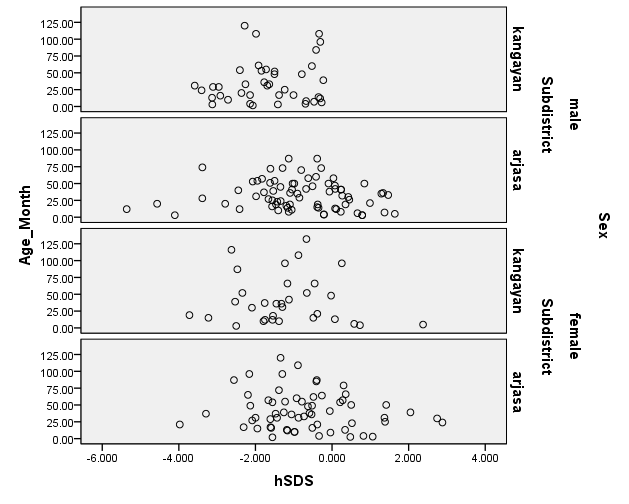
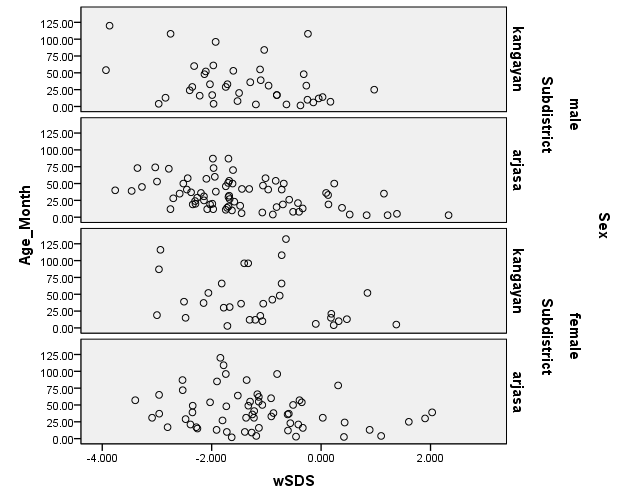
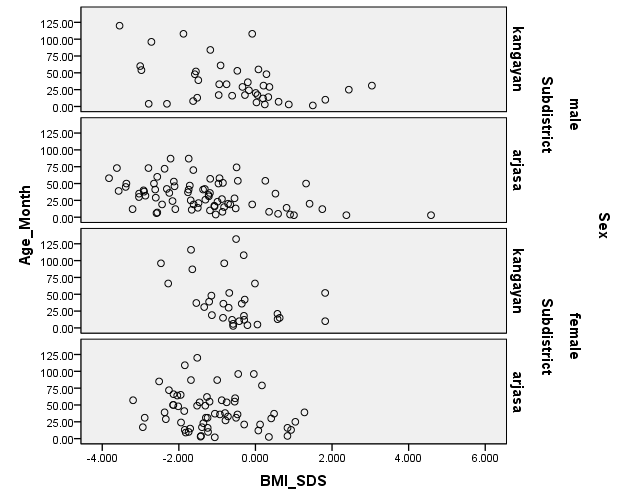
Figure 2 Comparison of height, weight and Body Mass Index (BMI) between children aged 1 month–under 12 years old on Kangean and other regions, based on the WHO Growth Charts (WHO 2007)
We discovered that, in accordance with our hypothesis, adolescents on isolated islands such as Kangean encounter limitations in growth regarding height, weight, and BMI. Nutrition and maternal health in utero regulate childhood growth, whereas psychosocial well-being and thyroid function support a 25cm per year growth rate in infancy. By 24 months, children reach their hereditary growth trajectory, growing 5–6cm per year. During puberty, sex hormone, growth hormone, sleep, and diet accelerate growth up to to 8–14cm/year (Mavinkurve et al. 2021). Adolescent girls on the Kangean Island exhibit shorter stature compared to their counterparts on the main island, indicating a failure to achieve their full height potential. Poor growth by the age of five often continues and can persist into adolescence and adulthood (Prendergast and Humphrey 2014).
Several studies in Indonesia have reported a higher prevalence of stunting in remote and rural areas compared to urban areas (Rachmi et al. 2016; Semba et al. 2008; Siswati et al. 2022). Our findings confirmed this and are also consistent with findings from Nabire, located in the central part of Papua Island at the western tip of Indonesia, where children exhibited shorter stature and lower BMI than their peers in Jakarta, a metropolitan city (Hasibuan et al. 2023).
Healthcare access is a significant challenge on the Kangean Island. The Island is served by three community health centers staffed with general practitioners and several midwives who cater to the health needs of the entire population. With sparse and often under-equipped medical facilities, this can lead to delays in receiving necessary medical care, including vaccinations and treatment for common illnesses. Inadequate access to healthcare has been linked to poor child growth. Semba et al. identified a fairly robust correlation between diarrhea occurring during the preceding 7 days and stunting in rural regions in Indonesia (UOR 1.30, 95% CI [1.22, 1.37]); another study found that children with complete, partial, or no vaccination had stunting prevalences of 37%, 47%, and 54%, respectively (Semba et al. 2008; Semba et al. 2011).
Limited availability of diverse and nutritious food options can also be a contributing factor. This scarcity is partly a result of the island’s isolation and the high cost of transporting goods, which can lead to diets deficient in essential nutrients (Losada-Rojas et al. 2021). Consequently, these nutritional deficiencies contribute to lower height, weight, and BMI among adolescents on Kangean. Economic constraints further exacerbate this issue, as many families on the Kangean Island may not have the financial means to afford a balanced diet. Insufficient purchasing power and various household wealth indicators were significantly correlated with child stunting in Indonesia (Torlesse et al. 2016).
Meanwhile, prior research has indicated that the influence of “nurture,” such as parental education has a more significant impact on a child’s height compared to predispositions inherited from genetics (Baten et al. 2013; Grasgruber et al. 2016; Stulp et al. 2015). Residents of the Kangean Island, including its youth, face significant challenges due to limited access to quality education. Schools on the island often lack adequate resources, such as qualified teachers and modern facilities. The isolation of the island also restricts exposure to broader cultural and educational experiences that are more readily available in urban areas. Low parental education and inadequate nutritional awareness correlated with stunting in urban poor children aged 6–59 months from 1999 to 2001, shortly after the 1999 economic crisis in Indonesia (Bardosono et al. 2007).
The concept of social or community-based growth adjustment suggests that an individual’s height during adolescence is influenced by the average height of their immediate social environment. During adolescence, a growth regulation mechanism tends to adjust individual height to align with the average stature of one’'s immediate community, Aßmann and Hermanussen (Aßmann and Hermanussen 2013) proposed a growth regulation mechanism wherein adolescents adjust their growth to align with the average stature of their peers, indicating a form of social peer group effect on physical development. In isolated island communities, such as the Kangean Island, this phenomenon may contribute to the restricted growth observed among children and adolescents who rarely meet urban people, and almost never, the tall European tourists. Limited genetic diversity and uniform environmental conditions may exacerbate these effects.
This commensurates with the hypothesis that children residing farther from the port exhibit shorter stature compared to those living closer, despite similar body weight. As the port serves as the primary conduit for movement and communication between the Kangean Island and the mainland, those living far from the port have limited access to external interactions and resources
This however, only applied for boys. In contrast, girls’ height and weight remained consistent regardless of proximity to the port. Boys show greater sensitivity to environmental stressors than girls. Also population density and greater economic stratification affects adult stature stronger in men than in women (Hasibuan et al. 2020). The increased sensitivity of males may occur due to biological and hormonal differences, as well as varying social and cultural expectations regarding sex (Stinson 1985). A meta-analysis of 16 demographic and health surveys from Sub-Saharan Africa revealed that boys were more susceptible to health inequities, particularly in families with low economic status (Wamani et al. 2007) while an Indonesian study (Torlesse et al. 2016) in 3 remote and rural areas reported that boys had a 77% increased likelihood of being severely stunted compared to girls (AOR 1.77; 95% CI 1.07-2.93). Social factors, such as differences in physical activity levels and healthcare access, might also play a role (Verma et al. 2011).
Children residing in Kangayan exhibited a higher BMI compared to their counterparts in Arjasa, despite boys being shorter. The data support the notion that being short does not necessarily imply shortage of food (Scheffler et al. 2020), but rather suggest an association between remotedness and short stature. Similar findings were reported from India with overweight/obesity being more prevalent than undernutrition among rural school children (Premkumar et al. 2019).
Parental education level is also associated with better growth (Scheffler et al. 2020). Kangayan area has only three equivalent high schools, while all state schools are located in Arjasa (Badan Pusat Statistik Kabupaten Sumenep 2021). Despite the lack of written data on the population’s education level, our analysis suggests that limited access to higher education and transportation challenges have resulted in a higher proportion of parents with low educational attainment in Kangayan.
The limitation of this study is that the primary data collected was anthropometric data only, without connecting it with various other variables that might contribute to children’s growth.
Children aged 1 month to 12 years and female adolescents (15–17 years) living on small islands like Kangean tend to grow slow, particularly if they reside in remote areas far from main transportation links to larger islands. The report emphasizes the need to break island disparity by strengthening educational facilities, transit networks, and targeted nutrition education initiatives to reduce future potential effects. Future research should expand on these findings to examine other aspects of child development in remote areas.
This work was supported by Faculty of Medicine, University of Airlangga, Surabaya, East Java, Indonesia.
Many thanks to the endocrine team of Dr. Soetomo Hospital, Surabaya, Indonesia, as well as to all participants for their willingness to engage in this research. Thanks should also go to the KoUP funding of the University of Potsdam of the 7th International Summer School “Human Growth and Statistics”.
Andayani, S./Rahmawati, E./Paramita, N. M. S./Arif, F./Satya, R. C./Wisanggeni, R. L. R. (2023). Social Cohesion of the Sulawesi Community in the Kangean Islands Society. In: Ramayda Akmal/Iping Liang/Vincenz Serrano et al. (Eds.). Proceedings of the Critical Island Studies 2023 Conference (CISC 2023). Paris, Atlantis Press SARL, 184–192.
Aßmann, C./Hermanussen, M. (2013). Modeling determinants of growth: evidence for a community-based target in height? Pediatric Research 74 (1), 88–95. https://doi.org/10.1038/pr.2013.50.
Badan Pusat Statistik Kabupaten Sumenep (2021). Kecamatan Kangayan dalam angka 2021.
Bardosono, S./Sastroamidjojo, S./Lukito, W. (2007). Determinants of child malnutrition during the 1999 economic crisis in selected poor areas of Indonesia. Asia Pacific Journal of Clinical Nutrition 16 (3), 512–526.
Baten, J./Stegl, M./Eng, P. van der (2013). The biological standard of living and body height in colonial and post-colonial Indonesia, 1770–2000. Journal of Bioeconomics 15 (2), 103–122. https://doi.org/10.1007/s10818-012-9144-2.
Checkley, W./Gilman, R. H./Black, R. E./Epstein, L. D./Cabrera, L./Sterling, C. R./Moulton, L. H. (2004). Effect of water and sanitation on childhood health in a poor Peruvian peri-urban community. Lancet 363 (9403), 112–118. https://doi.org/10.1016/S0140-6736(03)15261-0.
Fahmida, U./Santika, O./Kolopaking, R./Ferguson, E. (2014). Complementary feeding recommendations based on locally available foods in Indonesia. Food and Nutrition Bulletin 35 (4 Suppl), S174-9. https://doi.org/10.1177/15648265140354S302.
Fatimah, E. R./Paramita, N. M. S./Andayani, S. (2024). Structural Assimilation of the Bugis Community with the Native on Kangean Island. Jurnal Antropologi: Isu-Isu Sosial Budaya 26 (1), 51. https://doi.org/10.25077/jantro.v26.n1.p51-58.2024.
Grasgruber, P./Sebera, M./Hrazdíra, E./Cacek, J./Kalina, T. (2016). Major correlates of male height: A study of 105 countries. Economics and Human Biology 21, 172–195. https://doi.org/10.1016/j.ehb.2016.01.005.
Hasibuan, S. N./Djer, M. M./Andarie, A. A./Pulungan, A. B. (2023). International standard growth charts overestimate stunting prevalence in Nabire and Jakarta, Indonesia, compared to the Indonesian national growth chart. Clinical Pediatric Endocrinology 32 (2), 2022-0047. https://doi.org/10.1297/cpe.2022-0047.
Hasibuan, S. N./Pulungan, A./Scheffler, C./Groth, D./Hermanussen, M. (2020). Environmental stimulation on height: The story from Indonesia. Journal of Clinical and Anthropological Medicine 77 (5), 423–429. https://doi.org/10.1127/anthranz/2020/1209.
Hermanussen, M./Bogin, B. (2014). Auxology – an editorial. Italian Journal of Pediatrics 40 (1), 8. https://doi.org/10.1186/1824-7288-40-8.
Hudiyanto, R. (2007). Pahlawan yang Terlupakan: Pers Melayu, Etnik Thionghoa, dan Nasionalisme di Kota Malang 1920-1950. Humaniora 19, 215–223.
Kusumawardani, H. D./Laksono, A. D./Hidayat, T./Supadmi, S./Latifah, L./Sulasmi, S./Ashar, H./Musoddaq, M. A. (2023). Stunting Among Children Under Two Years in the Islands Areas: A Cross-sectional Study of the Maluku Region in Indonesia, 2021. Journal of Research in Health Sciences 23 (4), e00597. https://doi.org/10.34172/jrhs.2023.132.
Losada-Rojas, L. L./Ke, Y./Pyrialakou, V. D./Gkritza, K. (2021). Access to healthy food in urban and rural areas: An empirical analysis. Journal of Transport and Health 23, 101245. https://doi.org/10.1016/j.jth.2021.101245.
Mavinkurve, M./Azriyanti, A. Z./Jalaludin, M. Y. (2021). The short child: Importance of early detection and timely referrai. Malaysian Family Physician 16 (3), 6–15. https://doi.org/10.51866/rv1157.
Premkumar, S./Ramanan, P. V./Lakshmi, J. D. (2019). Rural Childhood Obesity - An Emerging Health Concern. Indian Journal of Endocrinology and Metabolism 23 (3), 289–292. https://doi.org/10.4103/ijem.IJEM_649_18.
Prendergast, A. J./Humphrey, J. H. (2014). The stunting syndrome in developing countries. Paediatrics and International Child Health 34 (4), 250–265. https://doi.org/10.1179/2046905514Y.0000000158.
Rachmi, C. N./Agho, K. E./Li, M./Baur, L. A. (2016). Stunting, Underweight and Overweight in Children Aged 2.0-4.9 Years in Indonesia: Prevalence Trends and Associated Risk Factors. PLOS one 11 (5), e0154756. https://doi.org/10.1371/journal.pone.0154756.
Scheffler, C./Hermanussen, M./Bogin, B./Liana, D. S./Taolin, F./Cempaka, P. M. V. P./Irawan, M./Ibbibah, L. F./Mappapa, N. K./Payong, M. K. E./Homalessy, A. V./Takalapeta, A./Apriyanti, S./Manoeroe, M. G./Dupe, F. R./Ratri, R. R. K./Touw, S. Y./K, P. V./Murtani, B. J./Nunuhitu, R./Puspitasari, R./Riandra, I. K./Liwan, A. S./Amandari, P./Permatasari, A. A. I./Julia, M./Batubara, J./Pulungan, A. (2020). Stunting is not a synonym of malnutrition. European Journal of Clinical Nutrition 74 (3), 377–386. https://doi.org/10.1038/s41430-019-0439-4.
Semba, R. D./Moench-Pfanner, R./Sun, K./Pee, S. de/Akhter, N./Rah, J. H./Campbell, A. A./Badham, J./Bloem, M. W./Kraemer, K. (2011). Consumption of micronutrient-fortified milk and noodles is associated with lower risk of stunting in preschool-aged children in Indonesia. Food and Nutrition Bulletin 32 (4), 347–353. https://doi.org/10.1177/156482651103200406.
Semba, R. D./Pee, S. de/Sun, K./Sari, M./Akhter, N./Bloem, M. W. (2008). Effect of parental formal education on risk of child stunting in Indonesia and Bangladesh: a cross-sectional study. The Lancet 371 (9609), 322–328. https://doi.org/10.1016/S0140-6736(08)60169-5.
Siswati, T./Susilo, J./Kusnanto, H./Waris, L. (2022). Risk Factors of Mild and Severe Stunting Children in Rural and Urban Areas in Indonesia. Iranian journal of public health 51 (1), 213–215. https://doi.org/10.18502/ijph.v51i1.8316.
Stinson, S. (1985). Sex differences in environmental sensitivity during growth and development. American Journal of Physical Anthropology 28 (S6), 123–147. https://doi.org/10.1002/ajpa.1330280507.
Stulp, G./Buunk, A. P./Verhulst, S./Pollet, T. V. (2015). Human Height Is Positively Related to Interpersonal Dominance in Dyadic Interactions. PLOS one 10 (2), e0117860. https://doi.org/10.1371/journal.pone.0117860.
Tauney, B. (2013). in. In: Charles Illouz/Philippe Grangé/Ari Anggari Harapan (Eds.). Kepulauan Kangean : Penelitian Terapan untuk Pembangunan / disunting oleh Charles Illouz & Philippe Grangé ; penerjemah Ari Anggari Harapan [and 8 others]. Jakarta, KPG (Kepustakaan Populer Gramedia).
Torlesse, H./Cronin, A. A./Sebayang, S. K./Nandy, R. (2016). Determinants of stunting in Indonesian children: evidence from a cross-sectional survey indicate a prominent role for the water, sanitation and hygiene sector in stunting reduction. BMC Public Health 16, 669. https://doi.org/10.1186/s12889-016-3339-8.
Verma, R./Balhara, Y. P. S./Gupta, C. S. (2011). Gender differences in stress response: Role of developmental and biological determinants. Industrial Psychiatry Journal 20 (1), 4. https://doi.org/10.4103/0972-6748.98407.
Wamani, H./Astrøm, A. N./Peterson, S./Tumwine, J. K./Tylleskär, T. (2007). Boys are more stunted than girls in sub-Saharan Africa: a meta-analysis of 16 demographic and health surveys. BMC Pediatrics 7, 17. https://doi.org/10.1186/1471-2431-7-17.
WHO (2007). The WHO Child Growth Standards. Available online at https://www.who.int/tools/child-growth-standards/standards (accessed 1/17/2025).
Widyaningsih, V./Mulyaningsih, T./Rahmawati, F. N./Adhitya, D. (2022). Determinants of socioeconomic and rural-urban disparities in stunting: evidence from Indonesia. Rural and Remote Health 22 (1), 7082. https://doi.org/10.22605/RRH7082.